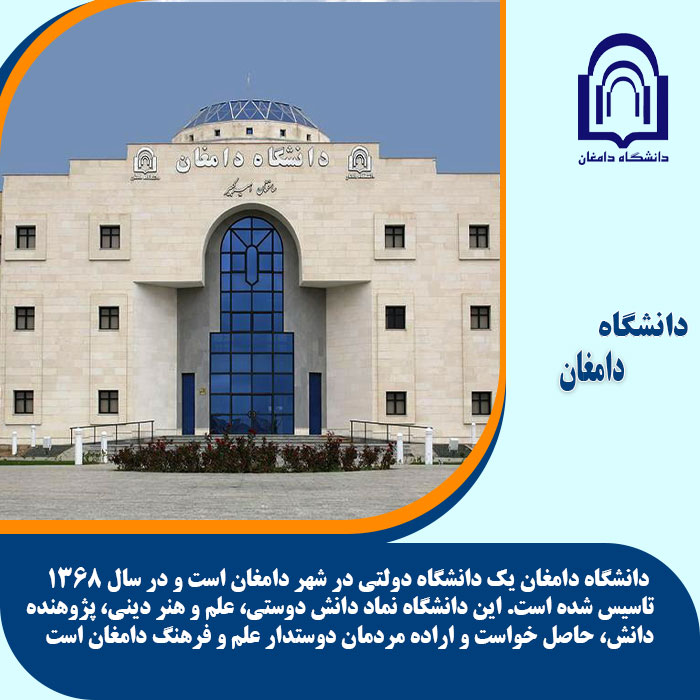Introduction
Damghan University is a public university located in the city of Damghan, in Semnan Province, Iran. The institution began its activities in 1988 (1367 in the Iranian calendar) with the establishment of the Faculty of Basic Sciences. Over the following years, by creating additional academic departments, it was promoted in 2002 (1381) to the University of Basic Sciences, and finally in 2010 (1389), with the establishment and integration of several faculties, it was upgraded to Damghan University. Currently, the university admits students in 68 academic programs at all levels. It consists of 8 faculties, with more than 5,000 students and 170 faculty members actively engaged in education and research. So far, the university has produced 2,120 national scientific papers and 1,890 ISI-indexed papers published in domestic and international journals and conferences.
Ranking
According to the Times Higher Education World University Rankings 2025, Damghan University has been ranked in the 1001–1250 band in Engineering.
Faculties
- Faculty of Earth Sciences
The Faculty of Earth Sciences, the first faculty of Damghan University, was founded in October 1992. Currently, it offers two undergraduate majors in Geology and Geography, as well as seven Master’s programs in Structural Geology (Tectonics), Stratigraphy and Paleontology, Economic Geology, Petrology, Engineering Geology, Environmental Planning, and Mineralogy and Industrial Rocks. The faculty is equipped with 13 specialized laboratories and workshops, including Microscopy, Sedimentology, Physical Geology, Photogeology and Mapping, Paleontology, Structural Modeling, Instrumental Analysis (with XRD and XRF, shared with the Faculty of Physics), ICP-EOS (shared with the Faculty of Chemistry), GIS Laboratory, Entrepreneurship Workshop, Engineering Geology, Economic Geology and Fluid Inclusions, and a Sectioning and Gem Cutting Workshop. - Faculty of Mathematics and Computer Science
Founded in October 1994, the Faculty of Mathematics and Computer Science currently consists of four undergraduate groups: Mathematics and Applications, Computer Science, Statistics, Economics, and Bioinformatics. The Mathematics group includes two subfields: Applied Mathematics and Pure Mathematics.
At the Master’s level, students may pursue Applied Mathematics (with specializations in Numerical Analysis, Optimization/Operations Research, Cryptography and Coding, Differential Equations, and Dynamical Systems) and Pure Mathematics (with specializations in Algebra, Analysis, Geometry and Topology, Graph Theory and Combinatorics). Computer Science Master’s programs include Scientific Computing, Soft Computing, and Artificial Intelligence.
At the PhD level, the faculty offers programs in Mathematics and Applications (Algebra, Mathematical Analysis, Optimization, Numerical Analysis, and Dynamical Systems) and Computer Science (Scientific Computing). - Faculty of Physics
Established in October 1996, the Faculty of Physics offers two undergraduate majors: Physics and Engineering Physics. At the Master’s level, it offers five specializations: Solid State Physics, Nanophysics, Nuclear and Particle Physics, Astronomy and Astrophysics, and Gravitation and Cosmology. At the PhD level, the faculty offers Condensed Matter Physics, Nuclear Physics, and Nanophysics. The faculty also operates an observatory and eight laboratories, including Basic Physics I, II, and III, Modern Physics, Optics, Nuclear Physics, Solid State (Educational), and Solid State (Research). - Faculty of Biology
The Faculty of Biology, one of the oldest faculties of Damghan University, formally began its educational and research activities in February 2007. At the undergraduate level, it offers three majors: Animal Biology, Cellular and Molecular Biology, and Plant Biology. At the graduate level, Master’s programs are offered in Plant Physiology, Systematic Ecology, Developmental Biology, Animal Physiology, and Biochemistry. In 2014, the PhD program in Animal Physiology was introduced. The faculty has 10 specialized laboratories: Plant Physiology, Plant Anatomy and Morphology, Animal Physiology, Behavioral Physiology, Biochemistry, Microbiology, Animal Tissue Culture, Electrophysiology, Plant Tissue Culture, and a Herbarium. - Faculty of Engineering
Founded in 2010, the Faculty of Engineering offers six undergraduate majors: Chemical Engineering, Computer Engineering, Industrial Engineering, Electrical Engineering, Mechanical Engineering, and Civil Engineering. At the Master’s level, it offers Power Systems in Electrical Engineering. The faculty aims to train skilled specialists, promote teamwork in research, increase scientific output, and foster creativity and innovation. With 31 faculty members, 7 specialists, more than 22 laboratories and workshops in Electrical Engineering, 11 in Mechanical Engineering, 7 in Industrial Engineering, 4 in Civil Engineering, 2 in Chemical Engineering, as well as 5 multidisciplinary laboratories, two computer sites, and access to the university’s computing server, the faculty actively collaborates with industry and supports knowledge-based companies. - Faculty of Humanities
The Faculty of Humanities was officially established in 2013 with the admission of graduate students in Criminal Law and Criminology. Later, it expanded to include undergraduate programs in Sports Sciences, Law, and English Translation, and a Master’s program in Arabic Translation.
The Sports Sciences Department operates an advanced laboratory for human movement assessment, physiological indices, physical fitness, motor skills, and neuro-cognitive functions. Its equipment supports studies in Exercise Physiology, Motor Behavior, Sport Biomechanics, and Corrective Exercises. The English and Arabic Translation Departments are equipped with an advanced language laboratory for training in listening-speaking skills, interpretation, and audio-visual translation. The faculty’s students also benefit from the central library, which houses extensive resources in Law, Sports Sciences, and Translation Studies. - Faculty of Art
Founded in 2011, the Faculty of Art admits undergraduate students in Dramatic Literature, Cinema, and Television and Digital Arts. In addition to teaching, the faculty also engages in artistic research. The faculty members have established the Research Center for Cinema and Dramatic Literature, enabling collaboration with other artistic institutions. Annually, the National Conference on Performing and Digital Arts is hosted here with participants from across Iran.
The faculty provides students with access to fully equipped facilities, including professional rehearsal and performance halls, a film studio, graphic and design workshops, puppetry workshop, photography laboratory, and computer labs for film editing and animation. The faculty is unique in Iran for having an open-air amphitheater with over 200 seats. Students also organize extracurricular artistic activities, including two major national festivals: the “Ordibehesht Theater Festival” and the “Hekatom Festival,” entirely managed by students with full support from the university administration.
Tuition Fees (per semester)
- Humanities and Arts (Master’s): 400,000,000 IRR
- Other fields (Master’s): 450,000,000 IRR
- PhD programs: 550,000,000 IRR
Address
Iran, Semnan Province, Damghan City, University Square, Damghan University.
